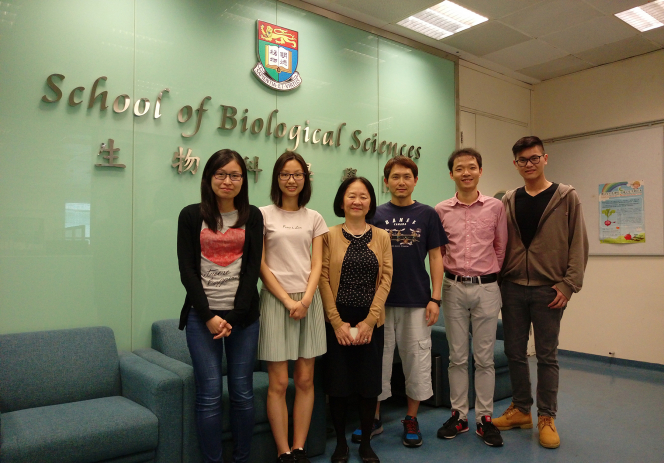Media
HKU-led biologists identify the switch for Neuroglobin gene
– a new target for Alzheimer’s disease
18 Oct 2016

Dr. Tan-Un and her her research team ( from left): Dr. Law Pui-pik (co-author of paper, former HKU-Imperial College London Joint PhD student), Dr. So Mei-yu, Dr. Tan-Un Kian Cheng (correspondent and lead author of paper), Chan Siu-kei (lab technician), Dr. Tian Zhipeng (co-author of paper) and Dr. Tam Kin-tung (first author of the paper).
A study led by Dr K.C. Tan-Un and her team at the School of Biological Sciences, the University of Hong Kong (HKU), in collaboration with Professor Richard Festenstein at the Clinical Sciences Centre, Imperial College London, and Professor Sjaak Phillipsen at Erasmus University, Rotterdam, have discovered a crucial part of the genetic machinery that switches on the Neuroglobin gene. This discovery opens up a new opportunity in treating Alzheimer’s disease (AD), such with the development of gene therapy. The study was published recently in the journal Nucleic Acids Research.
Neuroglobin has previously been shown to protect the brain of mice and is shown to reduce the severity of damage due to stroke and AD. In human, it is observed that the two major risk factors of AD, age and female sex are associated with lower levels of Neuroglobin. Identifying the “switch” for the neuroglobin gene is therefore of paramount importance, as it will serve as a potential target for the development of novel therapeutic treatments with gene therapy or drugs.
AD currently affects more than 70,000 people in Hong Kong and the number is estimated to reach 280,000 in 20 years because of the aging population. Currently the disease is incurable, thus there is an urgent need to find a treatment for the disease.
Since the discovery of the neuroglobin gene in 2000, studies have focused on its functions, yet little is known about how the gene is being regulated. The HKU team spent 6 years addressing the mechanism that controls the switching of the Neuroglobin gene. Dr. Tan-Un at HKU led the study with the hypothesis that there is a “switch” that controls the expression of the neuroglobin gene which is located far away from the gene itself.
The search of the distal DNA region has been technically challenging and the idea was tested by a series of experiments, carried out by two former PhD students, namely, Tam Kin-tung and Zhang Wei, including a technique called chromosome conformation capture (3C). The research team found that there is a segment of DNA which interacts with the Neuroglobin gene by means of a protein called GATA-2 in human neuronal cells. The results showed that the novel DNA segment is powerful in switching on Neuroglobin expression. Removal of either GATA-2 protein or the DNA segment from the cells led to a substantial decrease in Neuroglobin expression.
Professor Godfrey Chi-Fung Chan, a co-author from the Department of Paediatrics and Adolescent Medicine, HKU, said: “AD is an incurable disease at the moment and understanding the control mechanism of an important protector in the neural tissue such as Neuroglobin will provide us with a new therapeutic strategy. In fact, the role of neuroglobin is not confined to degenerative brain disorders, its aberrant role in neurogenic neoplasms is another interesting area to be explored. Therefore knowing how to ‘switch on’ or ‘switch off’ this molecule will help us to modulate a variety of human diseases.”
The discovery of the Neuroglobin switch opens up new opportunities in treating AD, such as the development of gene therapy. To effectively increase the expression of Neuroglobin to protect the brain, the gene together with the newly identified switch may be inserted into the genome. GATA-2 protein may also be manipulated by drugs to induce Neuroglobin expression. As the increase in neuroglobin expression is protective for AD, the team’s future research will focus on the identification of factors that will enhance the “switch” mechanism of neuroglobin in brain.
Dr. Tan-Un highlighted: “Further understanding this ‘switch’ and neuroglobin locus will be crucial in the design of efficient gene therapy system for the treatment of Alzheimer’s disease and other neurodegenerative diseases.”
The article "Identification of a novel distal regulatory element of the human Neuroglobin gene by the chromosome conformation capture approach" published recently in the journal Nucleic Acids Research* can be obtained from the following link:
http://nar.oxfordjournals.org/content/early/2016/09/19/nar.gkw820.abstract
*Nucleic Acids Research ranks within the top 6% of Biochemistry and Molecular Biology journals
Dr. K.C. Tan-Un is presently Honorary Associate Professor of School of Biological Sciences and School of Biomedical Sciences, the University of Hong Kong; and Principal Programme Director of School of Professional and Continuing Education, the University of Hong Kong.
Media enquiries:
Dr K.C. Tan-Un, Honorary Associate Professor at School of Biological Sciences (Tel: 2975 5881; email: [email protected]);
Communication and Public Affairs Office Ms Rhea Leung (Tel: 2857 8555 / 9022 7446; email: [email protected]);
Faculty of Science Ms Cindy Chan (Tel: 3917 5286 / 6703 0212; email: [email protected]).
